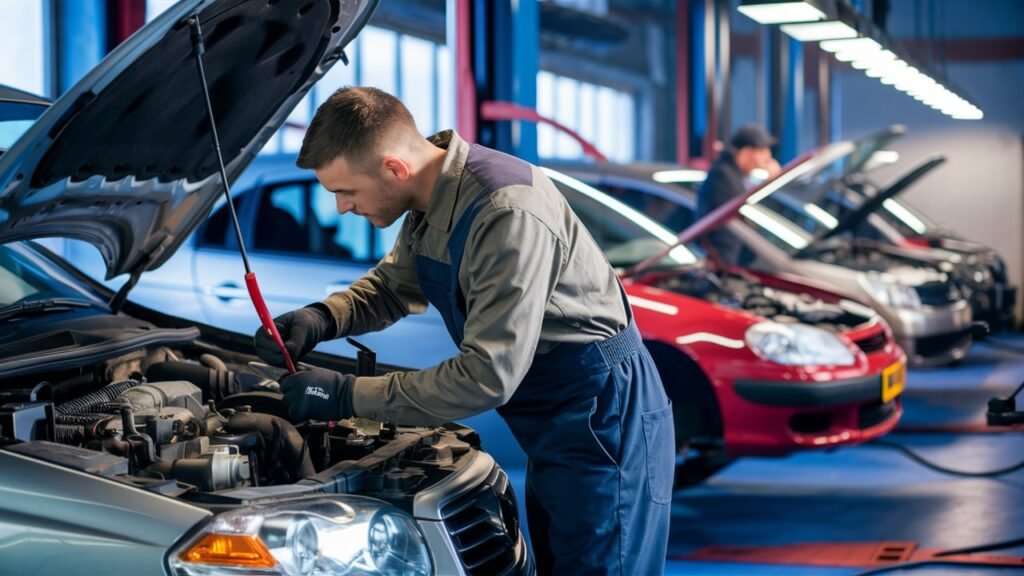
Unlocking the Secrets of Braking Response in Cars
Ensuring optimal braking response in cars is not merely a feature but a fundamental pillar of driver safety. The ability to swiftly decelerate can mean the difference between avoiding a collision and facing its consequences head-on. This critical aspect of vehicular operation hinges on the intricate workings of braking systems, which serve as the unsung heroes safeguarding drivers and passengers on every journey.
At the core of understanding braking response lies a complex interplay of physics, where concepts like friction and traction dictate stopping distances with meticulous precision. As vehicles tread various road conditions, from slick surfaces to dry asphalt, the efficacy of their braking mechanisms faces diverse challenges.
Delving into how divergent factors such as brake pad materials and tire quality influence this pivotal automotive function unveils a world where every detail matters in shaping driver safety behind the wheel.
Understanding these nuances becomes paramount for drivers seeking mastery over their machines’ responsive capabilities – an exploration that promises to deepen one’s appreciation for the mechanical marvels hidden beneath our vehicle’s exteriors.
The braking response in cars.
The braking response in cars is not just a process of stepping on the brake pedal; it involves a complex interplay of physics principles crucial for driver safety. At the core of braking response lie two essential elements: friction and traction.
When you press the brakes, the brake pads create friction against the rotors, converting kinetic energy into thermal energy to slow down the vehicle. Traction, provided by your tires gripping the road surface, plays a fundamental role in stopping your car effectively.
Understanding these fundamental principles can help drivers appreciate why maintaining proper tire pressure and tread depth is critical for optimal braking performance.
Various factors can influence braking distances, underscoring why a deeper understanding of these variables is crucial for safe driving practices. For instance, road conditions like wet or icy surfaces significantly impact how quickly a car can come to a stop.

The type of brake pad material used also plays a key role; ceramic pads are known for their superior performance in high-temperature situations compared to organic or semi-metallic ones. By comprehending these nuances, drivers can adjust their driving habits accordingly, ensuring they account for varying conditions that affect braking response.
Grasping the science behind braking response goes beyond theoretical knowledge—it empowers drivers to make informed decisions that enhance safety on the roads. With this insight, individuals can appreciate why proactive measures such as avoiding aggressive acceleration or sudden stops contribute to smoother braking responses and reduced risks of accidents.
Ultimately, delving into the physics of braking fosters a culture of conscientious driving where motorists prioritize maintaining their vehicles and adapting their behaviors based on scientific principles rather than relying solely on reactionary responses behind the wheel.
Types of Braking Systems.
Braking systems in vehicles are a crucial component of road safety, ensuring that drivers can stop their cars effectively and efficiently. Understanding the various types of braking systems used in cars is essential for both car enthusiasts and everyday drivers.
Two common braking systems found in modern vehicles are Anti-lock Brake Systems (ABS) and hydraulic brake systems. ABS prevents wheels from locking up during hard braking, allowing the driver to retain steering control. On the other hand, hydraulic brake systems utilize fluid pressure to transfer force from the driver’s foot to the brakes, resulting in effective stopping power.
In comparing traditional braking systems with newer technologies like regenerative braking, we see a shift towards more innovative approaches. Regenerative braking harnesses energy generated during deceleration to charge the vehicle’s battery.
This eco-friendly system not only enhances overall efficiency but also reduces wear on conventional brake components over time. While traditional hydraulic brakes offer simplicity and reliability, regenerative braking stands out for its sustainability and energy-saving capabilities.
Each type of braking system comes with its own set of advantages and disadvantages that are worth considering. Traditional hydraulic brake systems are known for their consistent performance across various driving conditions but may suffer from brake fade under heavy use.
On the other hand, regenerative braking excels in urban environments where frequent starts and stops occur but may lack strong deceleration power compared to hydraulic brakes at higher speeds. Understanding these characteristics can help drivers make informed decisions when selecting a vehicle or upgrading their current braking system configuration.
Factors Influencing Braking Performance.
Braking performance in cars is a critical aspect that can be influenced by various factors. One crucial element affecting braking efficiency is the vehicle’s weight. Heavier vehicles require more force to bring them to a stop due to increased momentum, impacting stopping distances.
For instance, a larger SUV traveling at the same speed as a compact car will take longer to come to a complete halt due to its higher mass. Understanding this relationship between weight and braking performance emphasizes the need for drivers of heavier vehicles to allow for more stopping distance.
Tire quality, size, and pressure play pivotal roles in determining stopping distances during braking maneuvers. Tires with proper tread depth and inflation levels ensure better traction on the road surface, facilitating quicker deceleration.

For example, under-inflated tires reduce the contact patch with the road, compromising braking efficiency and increasing stopping distances. Regularly checking tire conditions and maintaining optimal pressure levels enhance overall braking performance, especially in emergency situations where quick stops are necessary.
Maintenance practices directly impact the effectiveness of a car’s braking system. Monitoring brake fluid levels ensures that hydraulic systems function correctly without air bubbles or leaks that could compromise braking response.
Additionally, keeping brake pads in good condition prevents excessive wear and maintains consistent friction against the rotors for efficient deceleration. Neglecting brake maintenance can lead to brake fade or failure when needed most urgently, underscoring the significance of routine inspections to uphold optimal braking performance on all types of road surfaces and driving conditions.
Enhancing Braking Response Through Technology.
In recent years, advancements in automotive technology have revolutionized braking response capabilities, significantly enhancing vehicle safety. Two prominent features leading this charge are Automatic Emergency Braking (AEB) and Electronic Stability Control (ESC).
AEB is designed to detect potential collision risks and apply the brakes autonomously if the driver fails to react promptly, helping prevent or mitigate accidents. On the other hand, ESC monitors a vehicle’s stability and intervenes by applying individual brakes to specific wheels or adjusting engine power to prevent skidding or loss of control in challenging driving conditions.
The introduction of these technologies has resulted in tangible benefits that extend beyond traditional braking systems. AEB and ESC not only provide an extra layer of protection for drivers but also contribute to reducing the severity of accidents on the roads.
By leveraging advanced sensors and computing power, these systems can react faster and more accurately than human reflexes, potentially averting numerous collisions caused by delayed responses.
To maximize the effectiveness of these technological enhancements, drivers must understand how to integrate them seamlessly into their driving habits. While AEB and ESC offer invaluable support, they should complement—not replace—safe driving practices.
It is crucial for drivers to maintain attentiveness on the road and preemptively avoid hazardous situations whenever possible. By blending responsible driving behavior with cutting-edge safety features, motorists can create a synergistic approach that optimizes braking response capabilities for enhanced overall vehicle safety.
Best Practices for Improving Braking Response.
To enhance braking response and ensure your safety on the road, it is crucial to adhere to a few key best practices. First and foremost, maintain proper following distances between your vehicle and the one in front of you.
Adequate spacing allows for sufficient stopping time, especially in emergency situations where quick braking response can make all the difference. A good rule of thumb is to keep at least a three-second gap between you and the car ahead, adjusting for adverse weather conditions or higher speeds.
Regular brake inspections and servicing play a vital role in optimizing braking performance. By having your brakes checked by a qualified mechanic at recommended intervals, you can catch any potential issues early on and address them promptly.

This not only ensures that your brakes are functioning effectively but also helps prevent more costly repairs down the line. Consider brake maintenance as an investment in your safety on the road, prioritizing preventive care over reactive fixes.
When it comes to applying brakes while driving, practice smooth deceleration rather than abrupt stops. Gradually slowing down instead of slamming on the brakes reduces wear and tear on your brake system components like pads and rotors.
Additionally, smooth braking contributes to a more comfortable ride for passengers and minimizes the risk of skidding or losing control of your vehicle. By mastering this technique through consistent practice, you can improve not only your braking response but also overall driving efficiency.
The Future of Braking Technology.
As automotive technology advances at a rapid pace, the future of braking systems is poised for significant innovation. One area of exploration that holds promise is the development of more responsive and adaptive braking systems.
Manufacturers are investing in research to create intelligent braking systems that can anticipate potential hazards on the road and react instantaneously to prevent accidents. These systems may utilize a combination of sensors, artificial intelligence, and real-time data processing to enhance braking response times, ultimately improving overall vehicle safety.
With the rise of autonomous vehicles, braking technology is undergoing a transformative evolution. Self-driving cars rely heavily on sophisticated sensor arrays and computer algorithms to navigate roads safely.
This shift towards autonomy is reshaping braking response strategies by integrating automated emergency braking systems that can detect obstacles and stop the vehicle without human intervention when necessary. As autonomous vehicles become more prevalent on our roadways, these technologies have the potential to revolutionize how we approach braking in everyday driving situations.

The implications of these advancements in braking technology extend beyond individual drivers to impact car manufacturers, government regulations, and road safety standards. As new innovations emerge, manufacturers must adapt their production processes to incorporate cutting-edge braking technologies into their vehicles efficiently.
Additionally, policymakers will need to revise existing regulations to address the unique challenges and opportunities brought about by autonomous vehicles and advanced braking systems. Ultimately, these changes aim to enhance road safety significantly by reducing the likelihood of collisions and improving overall driving experiences for motorists worldwide.
In conclusion, the future of braking technology holds immense promise for enhancing driver safety and redefining how we interact with vehicles on the road. By embracing innovative solutions that prioritize rapid response times, adaptability, and automation, the automotive industry stands poised to revolutionize traditional braking paradigms in favor of smarter, safer driving experiences.
Through collaborative efforts between manufacturers, regulators, and technology developers, we can look forward to a future where braking systems play a pivotal role in preserving lives and preventing accidents on our increasingly connected roadways.
Conclusion.
In exploring the dynamics of braking response in cars, we have delved into the intricate science behind this fundamental aspect crucial for driver safety. Understanding how factors like friction, traction, and various braking system designs impact stopping distances is pivotal for every driver.
By comprehending the mechanics at work in braking systems and their interaction with external variables such as road conditions and tire quality, individuals can make informed decisions to enhance their driving skills.
As technology continues to evolve, advancements in braking systems are poised to revolutionize vehicle safety. The integration of innovative features like automatic emergency braking and electronic stability control underscores a shifting paradigm towards smarter, more responsive vehicles.
It is imperative for drivers to adapt to these developments by adopting best practices and staying abreast of emerging technologies that aim to redefine the future of automotive safety. With a focus on knowledge, maintenance, and adaptability, drivers can unlock the secrets of braking response in cars to ensure safer journeys for themselves and others on the road ahead.




